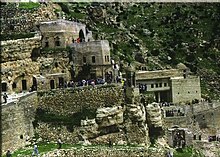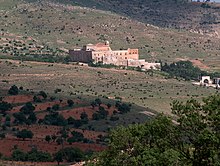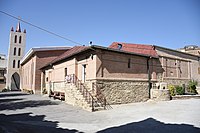Assyrian homeland
The territory that forms the Assyrian homeland is, similarly to the rest of Mesopotamia, currently divided between present-day Iraq, Turkey, Iran and Syria.
[3] The Assyrians are indigenous Mesopotamians, descended from the Akkadians, Sumerians and Hurrians[4][5][6] who developed independent civilisation in the city of Assur on the eastern border of northern Mesopotamia.
The territory that would encompass the Assyrian homeland was divided through the centre by the Tigris River, with their indigenous Mesopotamia on the west and western margins of the Urmia Plains, which they occupied in 2000 BCE prior to the arrival of the modern Iranians, to the east.
Similarly, in c. the early 25th century BC, Lugal-Anne-Mundu the king of the Sumerian state of Adab lists Subartu as paying tribute to him.
The Old Aramaic language was adopted by the population of the Neo-Assyrian Empire from around the 8th century BC, and these eastern dialects remained in wide use throughout Upper Mesopotamia during the Persian and Roman periods, and survived through to the present day.
The Assyrians suffered a significant persecution with the religiously motivated large scale massacres conducted by the Muslim Turco-Mongol ruler Tamurlane in the 14th century AD.
The mountainous region of the Assyrian homeland, Barwari, which was part of the diocese of Beth Nuhadra (current day Dohuk), saw a mass migration of Nestorians after the fall of Baghdad in 1258 and Timurlane's invasion from central Iraq.
[23] Its Christian inhabitants were little affected by the Ottoman conquests, however starting from the 19th century Kurdish Emirs sought to expand their territories at their expense.
Bedr Khan Beg of Bohtan renewed attacks on the region in the 1840s, killing tens of thousands of Assyrians in Barwari and Hakkari before being ultimately defeated by the Ottomans.
[38][39][40] Previously, when there were as yet no Catholic Aramaic speakers of Mesopotamian origin, the term "Chaldean" was applied with explicit reference to their "Nestorian" religion.
Thus Jacques de Vitry wrote of them in 1220/1 that "they denied that Mary was the Mother of God and claimed that Christ existed in two persons.
[50][51][52][53] Assyrians faced reprisals under the Hashemite monarchy for co-operating with the British during the years after World War I, and many fled to the West.
For a time he sought a homeland for the Assyrians in Iraq but was forced to take refuge in Cyprus in 1933, later moving to Chicago, Illinois, and finally settling near San Francisco, California.
The Assyrians of Dohuk boast one of the largest churches in the region named the Mar Marsi Cathedral, and is the center of an Eparchy.
Tens of thousands of Yazidi and Assyrian Christian refugees live in the city as well due to the ISIS invasion of Iraq in 2014 and the subsequent Fall of Mosul[55] In addition to the Assyrian population, an Aramaic speaking Jewish population existed in the region for thousands of years, living mainly in Barwari, Zakho and Alqosh.
The region was heavily affected by the Kurdish uprisings during the 1950s and 60s and was largely depopulated during the Al-Anfal campaign in the 1980s, although some of its population later returned and their homes were subsequently rebuilt.
[57] Following the concerted attacks on Assyrian Christians in Iraq, especially highlighted by the Sunday, August 1, 2004, simultaneous bombing of six Churches (Baghdad and Mosul) and subsequent bombing of nearly thirty other churches throughout the country, Assyrian leadership, internally and externally, began to regard the Nineveh Plain as the location where security for Christians may be possible.
This place of refuge remains underfunded and gravely lacking in infrastructure to aid the ever-increasing internally displaced people population.
The indigenous Assyrian homeland areas are "part of today's northern Iraq, southeastern Turkey, northwestern Iran and northeastern Syria".
[79] More than half of Iraqi Christians have fled to neighboring countries since the start of the Iraq War, and many have not returned, although a number are migrating back to the traditional Assyrian homeland in the Kurdish Autonomous region.
[88] The conference was organised by the European People's Party and had participants extending from Assyrian/Chaldean/Syriac organizations, including representatives from the Iraqi government and the KRG.









